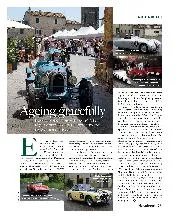
Ageing gracefully
It was the older cars in this year’s Mille Miglia which proved the most effective By Johnny Tipler Every one of this year’s 375 Mille Miglia entrants took part in…

Long ago I was asked to write an auction description of a pretty important competition car. The breathless owner was full of it, particularly since he had, at great expense, had its chassis-frame material sampled and analysed to verify its (correct) year of manufacture. “Oh yes,” he said, “I’ve had the chassis steel carbon dated…”
I was aware that carbon dating was pretty much confined to organic materials, ie those that once lived and grew. The radioactive isotope carbon-14 is absorbed during life by all living organisms, and dating is a technique used to determine the approximate age of once-living materials. It is based on the decay rate of C-14, which stops being taken up once life ceases. Thereafter C-14 decays and in the process emits its radiation. The decay rate is not rapid. For one half of the nuclei to decay (its half-life) takes 5730 years, but how far it has progressed can be accurately measured. Thus the length of time since the relevant organism was alive can be calculated, which works well for dating plant matter, bone, wood etc…
But here was this eager seller extolling the originality of his car because he’d just had its chassis “carbon dated” to 1958 or whatever. Quite apart from steel hardly being an ‘organic’ compound, carbon dating in those days really narrowed things down to something like 200-300 years. So I could take that as verification that his car dated, quite possibly, from somewhere between the Industrial Revolution and last Tuesday…
Back in February I experienced something of a time bracket of my own, in that I had to attend Bonhams’ Rétromobile sale in Paris. My particular time bracket of acquaintance spans about 1964 to 2019, since I hadn’t been there since covering the Paris Salon de l’Automobile when I were just a lad. This time I was riding shotgun on the five-Grands Prix-winning 1992 Williams-Renault FW14B that was Nigel Mansell’s famous ‘Red 5’ mount early that season, before becoming team-mate Riccardo Patrese’s ‘White 6’. Bonhams will be auctioning it at this summer’s Goodwood Festival.
During a break between being besieged with Williams enquiries, I was fascinated by a young German outfit that was promoting itself. Over some years Forensik has built a spectrographic database of steel mixes used in unimpeachably period-made original Bugatti and Alfa Romeo chassis. Similarly, Forensik has particular knowledge of original-period Porsche 911s, especially the now rare and extremely valuable 2.7 RS cars – and can spot a fake in minutes.
It backs up its sophisticated spectrographic materials database with non-invasive new techniques. X-ray scanning can detect the impact ‘shadows’ of number stamps that, in terms of visibility to the eye, have been ground away. Detecting over-stamping is a doddle. Micrometer thickness measurement can indicate when a plate or a stamp area has been ground down.
“Forensik can spot a fake Porsche 911 2.7 RS in minutes”
Such forensic techniques are widely used by authority to investigate firearms and falsified or facsimile artefacts. Forensik applies this kind of searching inspection to cars, old and new. The firm says it can now identify some steel mixes to a specific contemporary source, and also date some to within one year. Publicly they say they can date within 10 years, but they know more than they readily discuss…
They told me about collectible cars of the early 1970s – and 1930s – whose chassis frame material dated from no earlier than 1988. They have X-rayed a ‘vintage’ Bugatti’s reputedly pressed-steel (as-original) chassis frame… and found visually undetectable welded seams of mirror image left-side to right-side rail, so probably fabricated in a symmetrical jig – neither pressed nor hand-hammered, as the originals were.
There has always been an arms race between old-banger fakers and investigative authority. One hears stories of Chinese steels so poor in quality, and with so many inclusions, that they could be mistaken for middling-quality steels of the 1920s or ’30s. Forensik tells me in fact they don’t match, and have an unmistakable spectrographic signature of their own – again skulduggery if passed off as ‘period original’.
One has heard stories of pre-war railway line being melted down and reformed as ‘original’ period steel, to fool such analysis. Forensik says that’s a nice idea, but the 800-1,000degsC melting process evaporates a percentage of the lighter constituents, leaving a new signature that – to them – is again instantly recognisable.
So the verifiers are closing in on the fakers. However, I can’t see too many owners, dealers and agents readily submitting their ‘treasures’ for Forensik examination, although it’s relatively inexpensive, totally non-invasive and can take only half a day. I am sure sellers would prefer to find cheerfully naïve customers with a less inquiring (or less suspicious) mind.
Conversely, perhaps the day will shortly dawn when multi-million-pound car deals will go through only if the artefact in question is actually accompanied by a certificate of material originality…
If your German extends beyond ‘Hände hoch’, visit www.ifaf.eu.
Doug Nye is the UK’s leading motor racing historian and has been writing authoritatively about the sport since the 1960s